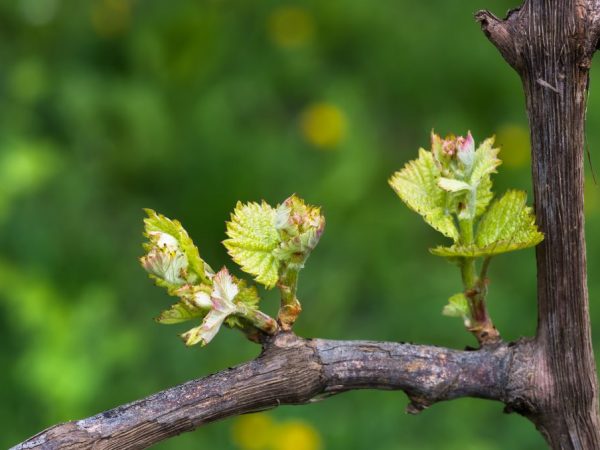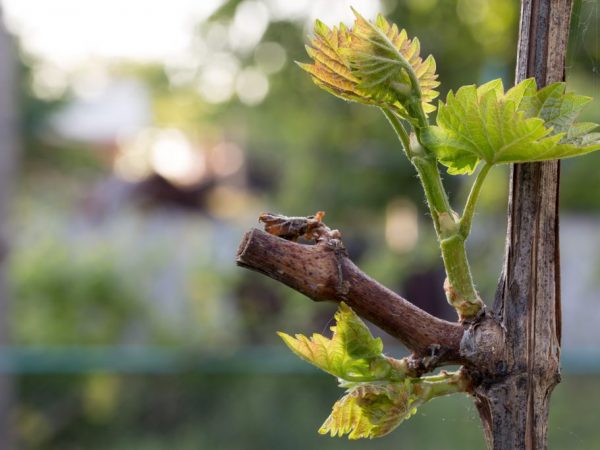Substitution knot on grapes
A correctly formed knot of replacement on grapes is a procedure that favorably affects the growth and development of the bush, its future fruiting.

Substitution knot on grapes
Substitution knot description
The replacement knots are fruit shoots. The difference between them is the different length. A twig is a short-cut vine, which is a spare in case of damage to the developed fruiting part of the plant. Together, these two parts of the bush form a classic fruit link.
Such a twig is a necessary precaution in adjusting the load on the branches of the plant. They are located below the fruiting arrows and are formed from young shoots. In a year, they will be able to create a vigorous fruiting branch.
It will also be possible to do without such knots, but such options for the formation of grapes will have some disadvantages. The vine is obtained from the lower annual shoots. The resulting sleeve will be long, which is why it is often difficult to cover the plant for the winter.
Cropping options
When forming grapes, attention is paid to favorable fruiting conditions, not only for the next season, but also for subsequent years. That is, each sleeve must have 1-4 fruit links. The function of the spare knot is to limit the growth of the culture, since without the adopted agrotechnical measures, the fruitful areas of the bush will move away from the trunk and suffer from a lack of nutrients.
You need to prune the culture in both spring and autumn. At the beginning of the growing season, replacement knots are formed, and at the end, branches that have already completed fruiting are pruned. The formation itself is different:
- with the removal of the replacement part;
- without removing a knot;
- pruning fruit arrows;
- strengthening of the fruiting link.
Each of these schemes has pros and cons. They choose one, taking into account the varietal characteristics of the grapes: growth rate, yield, etc.
With the removal of the knot
The main purpose of such removal is to create conditions for the formation of a fruiting arrow as a fruit link. Cut it off, leaving up to 15 buds on the vine. The renewal of the arrow without a spare knot is done by pruning the shoot obtained from the first eye of the vine.
Already next fall, the remaining long branch lends itself to cutting. Only 2 young processes are left. Cut them short, into 2 buds. In subsequent years, the operation was repeated.
To avoid possible problems with damage to the shoot, it is better to leave another one, a spare shoot. If it is damaged by frost, the bush will not lose its chances of fruiting.
No knot removal
Pruning grapes without knot replacement is carried out when 2 vines are formed on a young bush. One is cut into 3 eyes, and a sleeve is made from the second. With the end of the growing season, pruning of annual shoots is carried out. Only 5-10 of the strongest are left. The rest are disposed of.
The procedure is repeated with each subsequent year.The replacement knot is shortened only in the spring, and in the fall, work is done with the resulting sleeve. So, every year, the bush will increase the number of fruit vines. The winemaker will only have to choose the right shape for him.
Pruning fertile arrows

It is important to form a bush correctly
This is the most popular type of formation among winegrowers. If done correctly, it will be possible to create good conditions for fruiting. It is used only for non-covering grape varieties. The main goal is to grow bark on the vine so that the berries are juicy and sweet.
Only 2-3 buds are left on each fruit link. A distance of 15-25 cm is maintained between the links. The distance varies by the number of arrows. The greater their number, the greater the distance between them. With this formation, the shoots will become sleeves in the future. In the spring, the lower eye is cut into 3 buds. It will act as a replacement knot.
Strengthening fruit links
Strengthening is the use of 2 fruitful arrows. They are tied up to later get 2 high-quality fruit-bearing vines. The task of the grower is to determine the strongest shoots formed. They are left, and the weak are removed.
For the replacement knot, use the lower shoots on the fruiting link. The remaining second vine is removed. Such pruning is considered convenient for those who grow cover crop varieties. It contributes to the formation of a compact bush shape.
Like other pruning schemes, strengthening fruit links has both advantages and disadvantages. Among the pluses, a large number of green eyes are distinguished. This will help determine the number of kidneys affected by frost. The disadvantage is that a few green parts will have to be removed to comply with the shaping rules. That is, the plant loses part of the nutrients spent on providing branches and shoots irretrievably.
Reanimation of replacement knots
Replacement knots are often pruned by mistake without thinking about the consequences. In order not to destroy the plant, the procedure should be followed according to the rules.
There are 2 action plans for resuscitation of replacement knots. The first is the simplest.
- The most damaged shoots are removed.
- Weakly damaged shoots are pruned for fruiting.
- After a year, 1-2 of the strongest shoots are left.
- In autumn, the remaining parts of the plant are formed into a replacement knot.
This kind of substitution knot is universal. If done correctly, it is suitable for both covering and non-covering grapes.
The second method consists in shortening a strong shoot. They cut it into a twig. In the fall, on the fruit arrow, it will be necessary to remove all annual shoots. Such a scheme will also help preserve the yield of the crop, but it will not work for all its varieties. It is used only for grape varieties with high yields.
Conclusion
The replacement twig should be an equivalent replacement for the fruiting vine in the future. It will also be needed if the buds of the fruiting part of the plant are damaged in order to preserve the crop.


